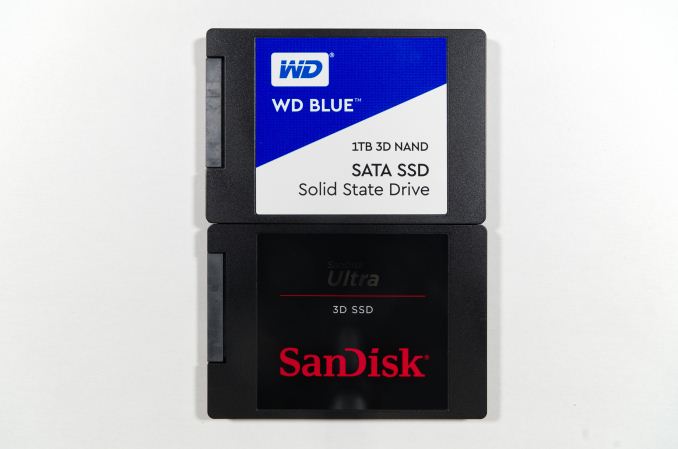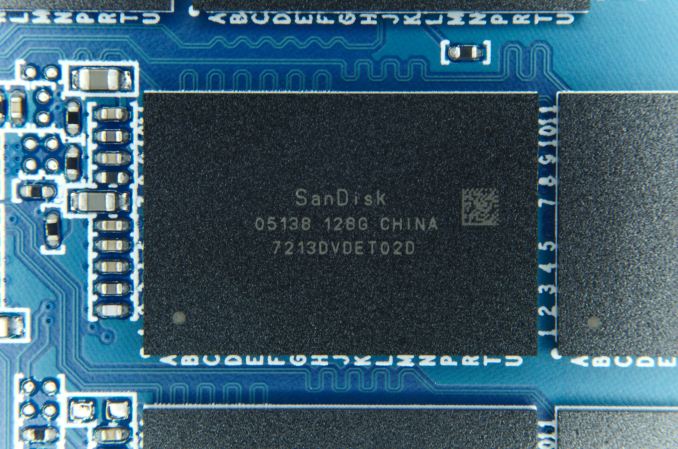One Design, Two Products: The SanDisk Ultra 3D (1TB) and WD Blue 3D (1TB) SSD Reviews, with BiCS 3D NAND
by Billy Tallis on September 14, 2017 9:00 AM EST
Western Digital, and its subsidiary SanDisk, have had some of the best performing planar TLC SATA SSD components in recent memory, so the bar is high for a new generation of SSDs. This review covers two drives which have the same design but differ in name only: the SanDisk Ultra 3D 1TB, and the Western Digital WD Blue 3D 1TB. Each drive will be targeted to the customer bases that appeal to each brand name.
The new drives don't change the basic formula that has worked in the past: the controller is the same Marvell 88SS1074 used in the original WD Blue SSD, and SanDisk is still developing the firmware in-house. SanDisk was a relatively early adopter of TLC NAND flash for consumer SSDs, starting with the Ultra II introduced in 2014. Prior to adopting 3D NAND, they had already moved to using TLC for their mainstream client drives, not just for entry level products. The original WD Blue SSD from last year used 15nm TLC, as did their flagship business/OEM SanDisk X400 client SSD.
SanDisk's 3D NAND, now in its third generation, is finally ready for mainstream SSDs. The NAND is a BiCS3 3D design, which uses a 64-layer charge trap flash design and is shared with Toshiba's 3D NAND. Western Digital has launched this 3D NAND in the retail market with a SATA drive that is being sold under both their SanDisk and WD brands. Like almost all current consumer SSDs with 3D NAND, the new SanDisk Ultra 3D and WD Blue 3D NAND SSD uses 3D TLC NAND flash.
Toshiba's version of this 3D NAND debuted in the Toshiba XG5 M.2 NVMe SSD for the OEM market, a drive we were quite impressed by. The SATA interface will limit how much the drives in this review can improve performance over their planar TLC predecessors, but there's still some room for improvement, especially around power consumption.
| SanDisk Ultra 3D and WD Blue 3D NAND Specifications | |||||
| Capacity | 250 GB | 500 GB | 1TB | 2TB | |
| Controller | Marvell 88SS1074 | ||||
| NAND | SanDisk 64-layer 3D TLC | ||||
| Form Factor | 2.5" 7mm M.2 2280 (WD Blue only) |
||||
| Sequential Read | 550 MB/s | 560 MB/s | 560 MB/s | 560 MB/s | |
| Sequential Write | 525 MB/s | 530 MB/s | 530 MB/s | 530 MB/s | |
| 4KB Random Read IOPS | 95k | 95k | 95k | 95k | |
| 4KB Random Write IOPS | 81k | 84k | 84k | 84k | |
| Idle Power (Slumber) | 56 mW | ||||
| Idle Power (DevSlp) | 5-7 mW | 5-12 mW | |||
| Write Endurance | 100 TB | 200 TB | 400 TB | 500 TB | |
| Warranty | Three years | ||||
| MSRP | $94.99 | $164.99 | $309.99 | $619.99 | |
The new WD Blue 3D NAND serves as the successor to the original WD Blue SSD, while the SanDisk Ultra 3D is a long-overdue replacement for the Ultra II. Both of the new products use the same technology under the hood; they differ primarily in the stickers on the outside of the drive and the retail packaging it arrives in. The product family includes capacities from 250GB to 2TB, and there is a M.2 SATA version available under the WD Blue branding. (The 2TB M.2 WD Blue 3D NAND has been announced but is not yet available.)
The performance and power specifications of the new WD/SanDisk drives are typical for a mainstream or high-end SATA SSD. Endurance ratings are good at slightly more than 0.3 drive writes per day, except for the 2TB model that is rated for just over 0.2 DWPD over the course of the three-year warranty.
For this review, Western Digital provided a 1TB WD Blue 3D NAND and a 1TB SanDisk Ultra 3D. Since these drives only differ cosmetically, their benchmark results should theoretically be the same. Any variations are due either to variability in our own tests, or to manufacturing variability that would be similar for two samples of the same model. We requested different capacities, which may come at a later date, although companies like to show off their best hand first - a 1TB drive is in peak of performance while not being as power hungry as a 2TB drive. It would still be interesting to get the other drives in to test, however.
This review will compare the WD Blue 3D NAND and the SanDisk Ultra 3D against the following drives:
- Last year's WD Blue, using SanDisk 15nm TLC and the same Marvell 88SS1074 controller
- The SanDisk X400, a slightly earlier drive using the same planar TLC and Marvell controller as the original WD Blue, but with different firmware and less overprovisioning.
- The Crucial MX300, Crucial BX300 and Intel 545s, representing all three variants of Intel/Micron 3D NAND that have hit the market so far. The MX300 uses 32L 3D TLC and the Marvell 88SS1074 and is the closest competitor to the new WD/SanDisk drives.
- The Samsung 850 PRO and 850 EVO, using Samsung 3D NAND and Samsung controllers.
- The Patriot Ignite 960GB, OCZ VX500 and OCZ Trion 150 (now branded TR150), all using 15nm planar NAND from Toshiba and thus comparable to the previous generation WD/SanDisk drives, but with controllers from Phison and Toshiba instead of Marvell.
| AnandTech 2017 SSD Testbed | |
| CPU | Intel Xeon E3 1240 v5 |
| Motherboard | ASRock Fatal1ty E3V5 Performance Gaming/OC |
| Chipset | Intel C232 |
| Memory | 4x 8GB G.SKILL Ripjaws DDR4-2400 CL15 |
| Graphics | AMD Radeon HD 5450, 1920x1200@60Hz |
| Software | Windows 10 x64, version 1703 |
| Linux kernel version 4.12, fio version 2.21 | |
- Thanks to Intel for the Xeon E3 1240 v5 CPU
- Thanks to ASRock for the E3V5 Performance Gaming/OC
- Thanks to G.SKILL for the Ripjaws DDR4-2400 RAM
- Thanks to Corsair for the RM750 power supply, Carbide 200R case, and Hydro H60 CPU cooler


















52 Comments
View All Comments
Foeketijn - Thursday, September 14, 2017 - link
We are talking about a Watt. Difference or so. Adding an extra fan has more impact. (Laptop? Who is upgrading a laptop with an 2,5" disk? Those are only found in really cheap devices anyway) The evo is known to just keep on going way way over that endurance point. How will these fare? We don't know yet. I think he has a fair point. There is no logical reason to choose this over a samsung other than not liking samsung. And samsung is just sitting there waiting till people notice their m2 driver are creaping to their sata prices. For a couple dollar more you get benchmarks that don't fit in these diagrams. I'm not a samsung fan. Just sad that no one is even trying to win this fight. The 850 evo is almost 3 years old and still on top for it's pricepoint (250Gb it is)mapesdhs - Thursday, September 14, 2017 - link
Indeed, so until I see tech akin to the 850 EVO come back down to the 55 UKP level for 250GB where it was at a couple of years ago, I just keep hunting for new or lighly used 840 Pro or other models via normal auction, bagged another 840 Pro 256GB recently for 51 UKP; would be fascinating to see how this model and others from previous generations of good SSDs would fare in these tests (Vertex4, Neutron GTX, Extreme Pro, Vector, etc.) Except for power consumption (who cares in a desktop), I doubt the latest models are that much better at all. I miss the days of buying an 850 EVO 500GB for 118 UKP (that was Oct/2015).Until then, there's better value in NVMe models with addin card adapters, eg. SM951.
Luckz - Wednesday, October 11, 2017 - link
When talking pound prices, it might be reasonable to mention how much your currency has changed since the 840 came out.Rictorhell - Thursday, September 14, 2017 - link
Hoping for someone, other than Samsung, to come up with a viable and somewhat affordable 4tb ssd, sata, or otherwise, so that prices at or near that capacity will become at least somewhat reasonable, someday, for those of us that need/want that capacity in an ssd.MajGenRelativity - Thursday, September 14, 2017 - link
That would be nice, but for now, you could just buy two SSDs and RAID them together?mapesdhs - Thursday, September 14, 2017 - link
That's one heck of a reliability risk.MajGenRelativity - Friday, September 15, 2017 - link
Depending on the RAID type, your reliability risk would be the same, or better. Could be worse, but that would be if you were doing a striped volume, which only increases performance, and I don't think OP was looking for thatCheapSushi - Sunday, September 17, 2017 - link
Yeah, so is having 1 PSU, no redundant power from difference sources, so is not having ECC RAM usually because anyone that does something with their computer is looking for six nines in uptime because they're obviously a datacenter...TheinsanegamerN - Sunday, September 17, 2017 - link
So is keeping 4TB of data on a single drive that can fail without warning.BrokenCrayons - Thursday, September 14, 2017 - link
Nice drives for a reasonable price and finally Samsung is starting to see a few competitive products but I don't think the focus is on SATA SSDs at this point. They're commonplace, but because the drive interface is limiting performance, we're unlikely to see any further high performance storage products for SATA which may explain why Samsung's not fighting very hard to keep a top tier drive there. They need mainstream and/or cost-effective storage which are essentially what SanDisk/WD, Crucial, and every other company that sells SATA SSDs ships out now. There's nothing wrong with that situation. I'm still on SATA and perfectly happy with the product selection out there now, but there's not much envelope left to push without shifting to interfaces like NVMe.